Savouring A Saturday While It Lasts
Saturday, August 23, 2008
 The New Westminster Horticultural Society showed up at 2 today to tour the garden. They were about 20 serious gardeners. Both Rosemary and I agreed that a garden tour in late August is a good thing as we would be more likely to let the garden go if nobody were coming to see it. This way it looked pretty good and it has given us a reinforcement that with the roses sporadically blooming now the hydrangeas and the hostas save the day. Eleven-year-old Rebecca is now much more difficult to handle. She did not show up in a dress at 2:30 but Lauren did. "I hate dresses," Rebecca told me. But when she saw my disappointment she went upstairs and reluctantly put on Ale's Mexican dress. She came down the kitchen stairs to the garden with a glum face but I loved her for it. When the girls come I try to do everything possible to prevent Rebecca from lazily going to the computer or to watch a mindless youth TV program complete with laugh tracks. Today Rebecca gave Lauren a longish piano lesson. Who knows, Lauren could be the musician of the family. She is keen. We all particularly enjoyed the sound of our 100 year old Chickering baby grand which we had tuned on Tuesday by Johann B. Krebs. Ale is here for the weekend from Lillooet. We are going to meet at Nando's at 6:30 for my very favourite very hot chicken. I will not forget to savour every moment. With Rebecca growing up and Ale being forced to drive to Vancouver a day with my wife, both daughters and granddaughters is a day to enjoy. 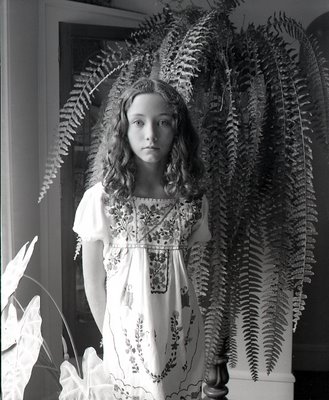 While I don't shoot digital I can still take a roll of film, in this case a discontinued Agfa ISO 400 b+w film, shoot it, process it and scan it within an hour. Here are two of the pictures I took today.
La Santa Muerte Smiles & I Don't Forget
Friday, August 22, 2008
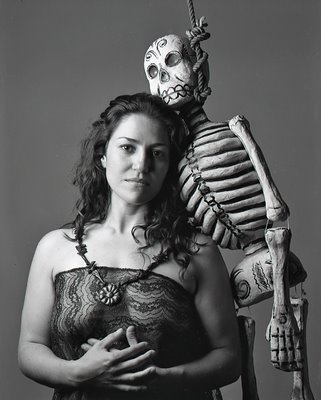
Jorge Wenceslao de Irureta Goyena and his first cousin Jorge Alejandro Waterhouse-Hayward were 8. We were riding a bus to Quilmes in the outskirts of Buenos Aires and Wency's father, My uncle Tony, told us with a smile, as our bus rounded a cemetery, "Someday I will lie there and you will come to visit me and everything will be just like today. You will remember." I never forgot. My Uncle Tony died in North Carolina. I don't know where he is buried. Wency disappeared from my life. He never left an impression with Google. But I do remember that day as our bus circled the cementerio. Strange how the spanish word for cemetery is closer to the idea that cement might just protect the body from decay. What nonsense!
In the late 60s my grandmother Lolita died in Mexico City. Uncle Tony came to the city for the services. His sisters, my mother Filomena and my aunt Dolly, took care of the preparations because Uncle Tony took me in search of his Holy Grail. At a bank he had seen a large golden cage with a stuffed parrot. He wanted a cage just like that. We went all over the city looking for that golden cage. People talked (in low voices) of the strange man who did not seem to grieve for his mother. I was confused yet Uncle Tony was no different from that other day those many years ago when our bus was rounding the cemetery in Quilmes and with a smile on his face he had told us that one day we would visit him. That day was the first day I met up with the idea of death. I will never forget. At the end of our life all that remains is that some might just remember us for a while and a few, just a few, might go out and celebrate life by looking for an impossible golden cage
Olvidos
He visto olvidos de todos tamaños
al pie de las cosas,
más largos que sombras.
Olvidos junto al árbol que corre
y junto al río que crece,
olvidos en las manos que aprietan
los senos que huyen presentes;
olvidos que salen a nuestro encuentro
en forma de encuentros
y pequeños silencios.
He visto olvidos antes del sueño,
y olvidos sobre olvidos
en el movimiento amoroso.
Yo he hecho una vida de olvidos,
una obra de olvidos.
El día que me muera
no será el día de mi muerte,
será el día de mi olvido.
El olvido de mi principio
se juntará al olvido de mi final.
Y todo, adentro y afuera de mí,
será olvido. Ojos de otro mirar Selected Poems, Homero Aridjis, A New Directions Book, 2001 edited by Betty Farber and George Mc Whirter
Forgettings
I have seen forgettings in all sizes
at the foot of things,
even longer than their shadows.
Forgettings next to a tree that runs
and next to a river that grows,
forgettings in hands that tighten
around breasts that flee being there,
forgettings that come out
in the shape of bodies
and small silences to meet us.
Before sleep, I have seen forgettings
and in the movement of love
forgettings on top of forgettings.
I have made a life of forgettings,
a way of forgettings.
The day I die
won't be the day of my death,
it will be the day of my forgetting.
The forgetting of my beginning
will be joined to my ending's.
And all, within me and without,
will be a forgetting. Eyes to See Otherwise Selected Poems, Homero Aridjis, Edited by Betty Farber and George McWhirter
Going through my collection of poetry of Homero Aridjis I conclude that if I hwere to be in a depressed mood I would call Aridjis the poet of death. But I remember his smile in the many times I have met him and I cannot be depressed even though so much of his poetry is about death. Note that the poem above is from a book that was edited by Aridjis's wife and his friend George McWhirter. Those who know might then know that Belfast born George McWhirter is Vancouver's Poet Laureate.
La Santa Muerte
Thursday, August 21, 2008
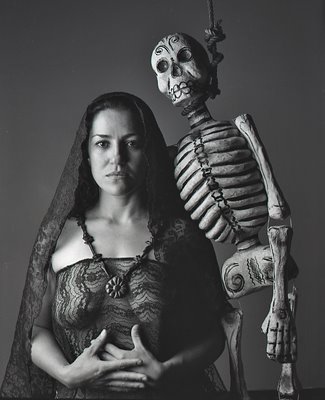 "La Santa Muerte" era el título de mi próximo artículo dominical. Karla Sánchez, una reportera de nuestro diario, había investigado la muerte de Jessica (así, sin apellido) a manos de La Flaca, una mujer bastante miserable con una sola capacidad: la de cometer un crimen horroroso en honor de la Santa Muerte. Con sus cómoplices Ojo Machucado, el Víbora y Cabeza de Piedra (fugitivos) había celebrado el asesinatoy desmembramiento de la dich Jessica en un cuartucho situado en el primer piso de un edificio nombre en un callejón anónimo de las orillas de una ciudad perdida. A los pies de una mesa que servía de altar se habían encontrado los despojos de la hoy occisa. Lado a lado, en un altar se habían colocado las imágenes de la Santa Muerte y de la Virgen de Guadalupe. El sincretismo de la Flaca saltaba a la vista al reunir bajo el mismo techo a la muerte azteca (representada por la Santa Muerte) y a la católica Virgen de Guadalupe. El altar estaba adornado por un cráneo humano, florero de vidrio rojo y cuchillos de carnicero. Velas rojas apagadas no lo alumbraban. A La Flaca se le halló acostada en un camastro rodeado de bolsas negras con basura, y con droga en una mesita de noche. En una hielera la cultista guardaba un camisón ensangrentado, vísceras humanas y una pantaleta (de Jessica)
"La Santa Muerte" era el título de mi próximo artículo dominical. Karla Sánchez, una reportera de nuestro diario, había investigado la muerte de Jessica (así, sin apellido) a manos de La Flaca, una mujer bastante miserable con una sola capacidad: la de cometer un crimen horroroso en honor de la Santa Muerte. Con sus cómoplices Ojo Machucado, el Víbora y Cabeza de Piedra (fugitivos) había celebrado el asesinatoy desmembramiento de la dich Jessica en un cuartucho situado en el primer piso de un edificio nombre en un callejón anónimo de las orillas de una ciudad perdida. A los pies de una mesa que servía de altar se habían encontrado los despojos de la hoy occisa. Lado a lado, en un altar se habían colocado las imágenes de la Santa Muerte y de la Virgen de Guadalupe. El sincretismo de la Flaca saltaba a la vista al reunir bajo el mismo techo a la muerte azteca (representada por la Santa Muerte) y a la católica Virgen de Guadalupe. El altar estaba adornado por un cráneo humano, florero de vidrio rojo y cuchillos de carnicero. Velas rojas apagadas no lo alumbraban. A La Flaca se le halló acostada en un camastro rodeado de bolsas negras con basura, y con droga en una mesita de noche. En una hielera la cultista guardaba un camisón ensangrentado, vísceras humanas y una pantaleta (de Jessica)
Página 14 y 15, La Santa Muerte, Homero Aridjis 2003, Alfaguara
"La Santa Muerte" was the title of my next Sunday article. Karla Sánchez, a reporter of our newspaper had researched the death of Jessica (like that, without a surname) at the hands of La Flaca (the Skinny One). La Flaca was fairly miserable and she had but one skill which was to commit a horrible crime in honour of La Santa Muerte. With her accomplices Smashed Eye, The Snake and Stone Head (fugitives) she had celebrated the murder and dismemberment of the aforementioned Jessica in a hell hole of a room on the first floor of a building with no name in an anonymous back lane at the edge of a slum. Beneath a table that served as an altar, they had found remains of the victim. Side by side on the altar lay images of La Santa Muerte and the Virgin of Guadalupe. la Flaca's sincretism was astoudingly obvious as under one roof she had brought together Aztec death (represented by La Santa Muerte) and the Catholic Virgin of Guadalupe. The altar was adorned with a human skull, red glass vases and butcher knives. Unlit red candles did not light the scene. The Skinny One had been found lying on a cot surrounded by black bags full of garbage and drugs on a bed side table. The cultist had placed in a cooler a bloody dressing gown, human organs and a panty (Jessica's).
Page 14 and 15, La Santa Muerte, Homero Aridjis, 2003, Alfaguara, my translation.
-Oh,Santa Muerte, protégeme y líbrame de mis enemigos, embóscalos, tortúralos, enférmalos, mátalos, hazlos picadillo, Oh Santa Muerte, que dominas el mundo, en nombre de los que aquí están postrados, te pido poder conra mis adversarios. Que no me quiebren, que no me arresten, que no me maten. Te pido, Santa Muerte mía, que no me desampares ni de noche ni de día, y que me defiendas de la traición de amigos y enemigos. También te pido la muerte violenta de los que buscan mi mal. Llévatelos a la Casa Oscura donde tiritan de frío los muertos. Llévatelos a la Casa de los Murciélagos, donde chillan y revolotean los heridos de bala y bayoneta. Llévatelos a la Casa de las Navajas, donde rechinan las armas blancas. Todo lo puedes tú, Santa Muerte, concédeme este favor. Amén.
Página 127-128 La Santa Muerte, Homero Aridjis, 2003, Alfaguara
Oh!, Santa Muerte, protect me and deliver me from my enemies, ambush them, torture them, make them sick, kill them, make them into mince meat. Oh! Santa Muerte, you who are in command over the world in name of those who kneel here before you, I ask you for power against my adversaries. That they do not break me, arrest me or kill me. I ask you, my Santa Muerte, that you do not abandon me night or day and that you defend me from the treason of my friends and enemies. I also ask for the violent death of those who seek to harm me. Take them to the Dark House where the dead tremble with cold. Take them to the House of Bats where those wounded by bullets and bayonets senselessly fly and scream. Take them to the House of Razors where blades and knives screech. You can do all this, Santa Muerte. Grant me this wish. Amen.
Page 127-128 La Santa Muerte, Homero Aridjis, 2003, Alfaguara , my translation.
Mexican poet and novelist Homero Arijdis has been writing about (in several excellent novels and books of poetry) the "sincretismo" or the ability of the Mexican aboriginal to combine and meld the ancient gods of the Aztecs, Toltecs, Maya, etc with the God of the conquering Spaniards to form a curious and interesting blend of beliefs, superstition and wisdom that is unique in our modern world. In his book La Santa Muerte he tells of the La Santa Muerte (a most feminine Saint Death) who is venerated by drug lords and their gang members.
Before the book was published in 2003 I received and email from Aridjis's wife Betty, informing me with much excitement about this book. She was right about her excitement as the book left in me a lasting impression. When my friend Abraham Rogatnick (86) who seems to be preparing for his death by getting rid of all his stuff gave me his 48-year-old Mexican papier-mâché skeleton I knew I somehow had a project. Ms Hernandez agreed and here she is a most beautiful but scary Santa Muerte. I told Abraham about it and he was delighted.
El Evangelista In The Fraser Institute Tie
Wednesday, August 20, 2008
evangelista.(Del lat. evangelista).
1. m. Cada uno de los cuatro discípulos de Jesús con cuyo nombre se designa uno de los cuatro Evangelios.
2. m. Persona destinada a cantar el evangelio en las iglesias.
3. m. Méx. Hombre que tiene por oficio escribir cartas u otros papeles a la gente que no sabe hacerlo.
Real Academia Española © Todos los derechos reservados
Your ordinary poor Mexican may not have any idea who Cyrano de Bergerac is as many (at least in my time in the 50s, 60s and 70s) did not know how to read or write. This did not prevent them from writing love letters, letters of condolence, letters to government bureaucracy or perhaps attempting to find a job with a nice and neat application letter. Cyrano's job was performed and perhaps even today by men (they were always men) called evangelistas. An evangelio (or gospel) is a letter. Evangelistas are the scribes of the populace. They set up shop under portales (long arched sidewalks in the centre of Mexican cities) with a typewriter (usually ancient) and paper. For a fee they will strive to please.
Rosemary has informed me that we used the services of an evangelista once for some sort of government petition re our house and we did not know the legal language to use. Our evangelista had no problem making a one sentence request occupy a whole page. Our request was granted.
Here Ms Hernandez is posing with my pinstriped suit which I purchased at the Puerto de Liverpool (sort of like Eaton's) sometime in 1972. Her tie, a Fraser Institute tie, (why not?) was given to me by a friend who worked for the institute. I tried to explain to Ms Hernandez what the Fraser Institute was but in the end I gave up.
That Linhof & Sipping Fanta On A Mexican Beach
Tuesday, August 19, 2008

I went to Beau Photo today. It is the only photo equipment and supply store that routinely stocks the Ektachrome 100G in 120 which is what I use to take photographs in colour. Sooner or later when that film and or labs in Vancouver stop processing I will have to purchase a digital camera for my commercial work. I will still shoot Ektachrome or whatever other film replaces it and I will have it processed in Toronto or New York. When it becomes impossible it is my hope that by then I will have been vaporized in some lucky accident and my widow will be sipping Fanta on a Mexican beach.
While in Beau Photo I went from the film, paper and other stuff side of the store to the photo equipment and studio lighting side of the store. With my bag of film ($300 worth) I stared at all the lighting stuff that makes what I use look like a Studebaker Scotsman (this Studebaker tried to bring the idea of frugality and it sported no chrome. The idea was ahead of its time so the car failed).
An elderly man (I guess if I looked at myself in a mirror I would define myself as one) was getting rid of all his ancient gear. There were a couple of nice looking Pentacon Six 6x6cm cameras, one Mamiya RB-ProS like mine with two lenses, some sort of 4x5 inch field camera and a 6x6cm slide projector that looked like it had bored audiences for many years. The man looked at me and with a smile he said, "I am selling my stuff, I am downsizing and moving to an apartment. You know how it is?" I had to tell him that his Pentacon Sixes were dogs that had been made by reluctant German engineers in the Russian Occupied Zone of Germany and later by the same engineers, turned lazy bureaucrats of East Germany in the fine city of Dresden. "They have their peculiarties but as long as you know what they are the cameras work just fine." Whe he told me that, I countered with, "These were built before Germans started making good Audis." I did not remind him that the predecessors of Audi at that time were making DKWs that had a three cylinder engine that sounded like eggs frying in deep fat. But I admired his 140mm Mamiya lens with a floating lens element (I own two of these extremely sharp lenses). He smiled at me more generously. When he left with his receipt, what he had last told me reverberated in my head, "If they offer me too little I will take them back and give them away."
About four years ago I went to MCL Motorcars to photograph a man who managed the exotic automobile section of the company. I admired a beautiful dark blue Aston Martin. The man, an Englishman, barely smiled under his moustache and then sadly told me, "Don't look under the hood, it's a Ford."
Every once in a while when I am using my two Nikon FM-2s which are nicely finished in metal and make satisfying clicks I think of where they came from. I think of the exotic Contax of the 1930s (more desirable to me than a Leica) and how that kind of machine work and fine manufacturing is all but dead. My German repairman, Horst Wenzel fixes mechanical cameras and restores them. He was trained at the Hasselblad plant and instinctively knows how mechanical cameras work. But he will not look at the latest crop of cameras. You need computers to access information on where and how to repair them. You have to be an electronics wizard. You have to be so specialized that you might be able to look into the latest Nikon but not the Canon.
I cannot believe that somehow the Germans started all this with their people's car, the VW Beetle. By early 70s my Mexican VW repair facility in Mexico City would plug into my car and check on a computer the compression of the engine. I was given the readout and told that my engine was in good shape at 90%.
I remember going to McQueen Sales (the Canadian representative of Asahi Pentax) in the early 80s with a Pentax ME Super that had failed me at a job. Kas, the consumate Japanese technician told me, "We have a new improved circuit board for it." The folks at Pentax in Vancouver had known beforehand that I had a camera with a faulty circuit board and had not bothered to call me. When Horst repairs my mechanical cameras I can expect them to work well for a long time.
When the sad man at Beau Photo showed me his 6x6 slide projector, I had to point out that I own a 6x7cm Linhof slide projector with Leica lenses (not an Aston Martin with a Ford engine). I can project my 6x7cm Ektachromes and fill the Orpheum stage wall if given the chance. The projector is manual and I have to put each slide, one at a time and shift the beautifully made slide holder seen here. It is solid metal and it makes a satisfying clunk if you slide it with spirit. If you don't the projector makes no sound and the cooling fan is not audible. 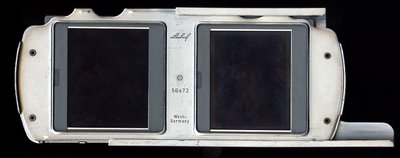
As I teach at Focal Point and I have to maneuver the operation of digital slide projectors (the images they project are of doubtful quality) I realize that an era has gone by. Cameras, people tell me, are efficient tools. They make (or capture images). I would not even begin to explain to them how I love my cameras and that they are more than just efficient tools. How can I tell them that I like to look at the nicks of imperfection or the effects of my hard use? They are my friends and companions of something I love to do. I take pictures, I don't capture pictures. The first implies a gentle cooperation with my subjects and with my cameras while the second seems almost aggresively violent.
It can only be a short time when I will probably take the plunge made by that old man and downsize, too. I don't look forward to it. Vaporization sounds like a better idea. Will I go alone or in the company of my friends?
A White Ghost At UBC
Monday, August 18, 2008
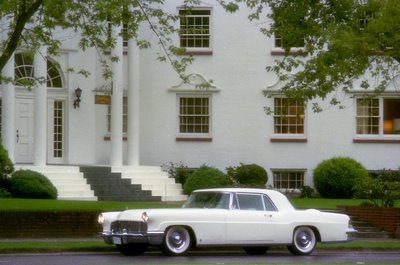
The 1956-1957 Lincoln Continental Mark II was the mid-'50s successor to the original Continental of the '40s. It was magnificently styled by a team including John Reinhart, William Clay Ford, and Gordon Buehrig. Engineer Harley Copp's unique "cowbelly" frame dipped low to permit high seating without a tall body.
With Multi-Drive three-speed automatic and a balanced, individually tested Lincoln V-8, the Mark II was marketed as an image leader intended to steal Cadillac's thunder in the ultra-luxury class.
Despite beautiful styling, it didn't sell well, probably because its price was so close to the (then) breathtaking $10,000 mark.
Last Thursday Rebecca, Graham Walker, Abraham Rogatnick and I went to UBC to the Chan Centre to listen to Rameau's Pygmalion presented by Early Music Vancouver. We picked up Rogatnick on our way. He lives on 11th Avenue and Trimble. We then proceded by Chancellor Boulevard. I have always been confused since it is similar (at the tail end near UBC) to University Boulevard. At one time what looked like a stately American antebellum mansion sat at the end. It is gone and there is a lot of construction of what looks like luxury condonminiums.
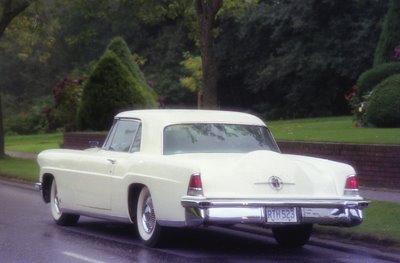
It was in front of that mansion that I photographed sometime around 1977 the most beautiful car in the world. It was an 1956-57 Lincoln Continental Mark II and its owner had hired me to take pictures of it. Little did he know that I knew little of this. I managed to overlook the rule that cars should be photographed free of distortion. I even (cringe) used a star filter to put stars on the headlights.

But I remember the mansion and the automobile fondly. I found the colour negatives in my files and had to use the colour restoration device of my scanner as those colour negatives had deteriorated with time. Even now that car seems to be a beautiful ghost with an existence all of its own.
Sunday, August 17, 2008
"Mental prayer [oración mental] is nothing else than a close sharing between friends; it means taking time frequently to be alone with him who we know loves us." Santa Teresa de Jesús (St Teresa of Ávila)  Several events today made me suddenly turn into thinking about religion. At least in the sense that I want to write about it without in any way wishing to rant, nor is it my intention to proselytize. I talked to my godmother (and first cousin) Inesita on Skype today. She is 86 and lives in Buenos Aires. She was visiting her son Georgito with whom I have been close since we independently served in the army (he) and the navy (me) in 1965. We talked and looked at each other for close to two hours. We talked about old age pensions (he is 64, I am about to be 66). In the end our conversation had to terminate because he was going to Sunday Mass. He made the comment (wrong one) that my last time at church was probably after my first communion. He was wrong, after all I went to a Catholic boarding school (high school) for four years. It was at St Edward's High School that Brother Edwin Reggio C.S.C. taught me that perhaps the most important sacrament is that of confirmation. Confirmation, Brother Edwin had told us, made us soldiers of Christ. It made us defenders of our faith. It made us defenders (not in any agressive way) in being able to explain doctrine and our beliefs with clarity to those who might want to know. I remember returning from my military service in Buenos Aires to Mexico and somehow ending up at Sunday Mass in a church not far from my Tia Fermina's. The service was odd to me in many ways. I had grown up with the classical Latin Mass. In this Mexican church the priest was facing us and speaking to us in Spanish. I understood somehow that Pope John XXIII and the Second Vatican Council were responsible for this strange turn of events at Mass. At one point during the service, the people by my side (I did not know them from Adam) suddenly embraced me. I was confused but they explained to me that this was the people's Mass and that's how things were done. My further but infrequent journeys into Catholic Mass services became mandatory funerals and the odd wedding. Sunday Mass was as dead to me as that April 8, 1966 Time Magazine cover, Is God Dead? But it has been very difficult to let go. Consider that when I was 8, 9 and 10 my grandmother came to visit us to our Coghlan house in Buenos Aires on Good Friday. I was brought in from playing with my Jewish friend (Mario Hertzberg) out in the street and told to kneel in the living room. The time was somewhere around 3 in the afternoon when my grandmother asserted our Lord had died. She often would say that my friend Mario's ancestors, the Jews, had cruelly crucified our Lord. She would then lead us to recite the last words of Christ. The day was ever more depressing as I was told that we could not listen to any music. It was about this time (1952, 1953) that Father Filippo informed us that if we did not become followers of Perón we would roast in hell. In the mid 50s my mother was stricken by a terrible disease (it can be controlled now but it is still incurable) called Meniere's. This disease attacked the inner ear. It began with a buzz that got louder and louder. It was constant and it came with terrible attacks of nausea. My mother would just fall and would spend hours in bed holding on for dear life. Eventually the buzz and the disease destroyed her sense of balance and made her deaf even though the buzz never went away. By 1972 she was telling me that she wanted to die. One very terrible day she confessed to me that she had lost her belief in the power of prayer. "I do believe in God, " she told me, "but I don't believe in a God who cares about us. He is up there somewhere and is detached from human existence. We must really think we are important that He would want to listen to each one of us." And she died and Rosemary and I listened as she breathed in and never did exhale. All the above went through my head today. Hilary lent us her copy of Milos Forman's Goya's Ghost. I know my Spanish history and I did note a few innacuracies of time compression, but the film was horrific in its display of the power of the Inquisition and the Catholic Church as the 18th century waned. Having studied theology in school I understood the events of the film. The situation with the so called "trials" of the Inquisition have the also horrific parallel with those of the contemporary detention camps for terrorists in our Western world. We have simply not changed even if we do embrace at Mass. Rebecca has seen this film and I wonder how at age 11 (today, happy birthday Rebecca) she can possibly understand all the complexities and intricacies of this disturbing film. Would she smile (no)? Or gasp in horror (no)? when my grandmother would point at some man with a large nose and say in her Castilian Spanish, "That man has the map of Jerusalem on his face." I have mentioned here of my admiration for Graham Greene and of his novels of flawed protagonists who would lose their faith. In some small way this man (me) a product of the Latin Mass who was shockingly modernized with an embrace (not quite on the Concorde) has lost his way. I look longingly at this photograph of my mother's first communion in New York City in 1920. Here, too is her rosary (of pressed rose petals) and dedicated to St Teresa of Ávila. Will I ever know which of them was right?
|

















